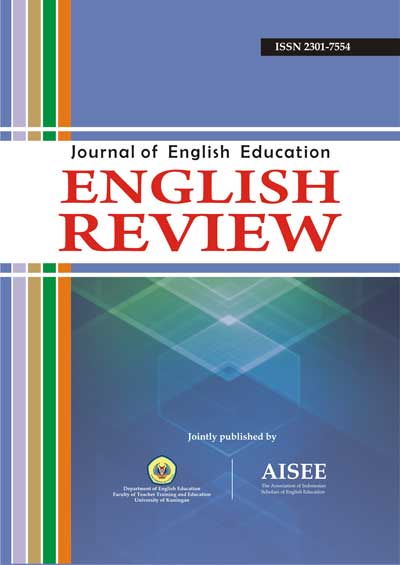THE CHARACTER ANALYSIS OF GLEN HANSARD IN ONCE FILM
Abstract
Abstract: This paper analyzed the characterization of talented actor named Glen Hansard in Once film. This study employed a descriptive qualitative research design based on theories of Rahardjo (1985), Robert (1965), and Card (1988). Primary data sources were whole Once scenes film directed by John Carney which had low-budgeting production with two stars, Glen Hansard and Irglova, while secondary data sources were collected from the articles related to this study. This research mainly investigated two aspects involved two character analyses of the main actor, Hansard. The first one was the construction of Hansard’s characters and the second one was the effect between his character and another actors’ character. The study showed that Hansard’s characters were constructed by five factors: from what the character did and said, what the other characters said about him, how the appearance and its milieu were, influencing one and another.The study also found that he had struggle, visionary, ambitious, introvert, sensitive, straightforward and curious characters, but more characters that showed strong characters of his were struggle, visionary and ambitious, because the scenes reflected them more.
Keywords: literary works, film, character, characterizing.Â
References
Armada (2008). Cambridge advanced learner dictionary (3rd edition). Cambridge: Cambridge University Press.
Barklee. (2013). GlendHansard. Retrieved January 12, 2013, from http://www.berklee.edu/events/detail/13381/glen-hansard
Downloadmoviesfree. Once film 2006. Retrieved September 8, 2012, from http://downloadmoviesfreee.org/once-2006-download-movies/
Hawthorn, J. (2001). Studying the novel (4th Edition). London: Hodder Headline Group.
Hollywood Movies. Exclusive interview. Retrieved September 5, 2012, from http://movies.about.com/od/once/a/once052007.htm
Klarer, M. (1998). An introduction to literary studies. London: Routledge.
KPBS. (2007). Once/Interviews with John Carney and Glen Hansard. Retrivied September 6, 2012, from http://www.kpbs.org/news/2007/may/24/onceinterviews-with-john-carney-and-glen-hansard/
Lestari, A. R. (2012). A Struggle for Love of Bellas Swan Reflected in New Moon Movie: an Individual Psychological Approach. ENGLISH REVIEW: Journal of English Education, 1(1), 86-96.
Name, J. (2009). Study Guide for the Ireland Film Once. The British Schools Film Festival, 1-10.
Rahardjo, H. (1985). Pengantar kesusastraan Inggris. Surakarta: Sebelas Maret University.
Robert, E. V. (1963). Writing theme about literature (5th Edition). New Jersey: Prentice Hall.
Ryan, M.(2010). Approaching the other through music in john carney’s film once. EssaysandStudies.http://webcache.googleusercontent.com/search?q=cache:vcpecC925GoJ:www.otherness.dk/fileadmin/www.othernessandthearts.org/Publications/Journal_Otherness/Otherness__Essays_and_Studies_1.1/Sounding_Different_Notes.pdf+&cd=1&hl=en&ct=clnk Accessed 31 January 201308
Sari.M.A.(2012). Analisis karakter dan konflik tokoh utama dalam novel Bocchan karya Natsume Souseki. Bandung: UNIKOM.
Scott Card, O. (1988). Character and viewpoint. Cincinnati: Digest Books.
Smith, N. (2011). Character analysis trip glory. Retrieved June 19, 2013, from http://www.articlemyriad.com/character-analysis-trip-glory/
Stlyrics. Browse by soundtrack. Retrieved June 02, 2013, from http://www.stlyrics.com/lyrics/once/whenyourmindsmadeup.htm
Subscene film. Once English subtitle. Retrieved June 19, 2013, from http://subscene.com/subtitles/once/english/116056
Sugiyono. (2011). Metode penelitian pendidikan. Bandung: Alfabeta Bandung.
Wikipedia. Once. Retrieved June 19, 2013, from http://en.wikipedia.org/wiki/Once_(film)
All articles published in English Review: Journal of English Education (ERJEE) are licensed under the Creative Commons Attribution 4.0 International License (CC BY 4.0).
Copyright Ownership
Authors retain the copyright of their articles and grant ERJEE the right of first publication. The journal is granted a non-exclusive license to publish, reproduce, and distribute the article in any format, medium, or platform, provided that proper credit is given to the original authors.
License Terms – CC BY 4.0
Under the Creative Commons Attribution 4.0 International License, others are free to:
- Share — copy and redistribute the material in any medium or format
- Adapt — remix, transform, and build upon the material for any purpose, even commercially
As long as they:
- Provide appropriate credit to the original author(s) and source
- Provide a link to the license (https://creativecommons.org/licenses/by/4.0/)
- Indicate if any changes were made
There are no restrictions on the reuse, reproduction, or adaptation of published articles as long as attribution is properly given.
Author Warranties
By submitting a manuscript to ERJEE, authors confirm that:
- The work is original and does not infringe any existing copyright.
- The manuscript has not been previously published and is not under consideration elsewhere.
- All sources and references are appropriately acknowledged.
- Necessary permissions have been obtained for any copyrighted materials used.









